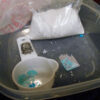Nearly 20 million U.S. adults experience a substance use disorder (SUD) annually,1 leading to more than 650 thousand hospital admissions.2 Large-scale crises like the COVID-19 pandemic can precipitate substance-use relapses,3 compounding the problem of already scarce hospital resources. Little is documented about patients reporting a pandemic-related relapse and resultant hospitalization.
A sample of patients was gathered during usual care at an urban, safety-net hospital. These patients each had at least one SUD and were evaluated by an addiction consultant prior to discharge. Upon a patient reporting, unprompted or in response to the question, “Did the pandemic affect your substance use?” that their use increased related to the impacts of the pandemic, their chart was added to a secure list.
Individuals from the pandemic-relapse cohort were compared regarding demographics, hospital utilization, and primary substance to all remaining consult patients seen by the same provider (D.T.) during the same period. Several findings were tested (H0 = no difference between groups) using standard statistical methods (Chi-square for categorical data, t-test for numerical data), with an alpha of 0.05. This project was granted a waiver of consent and an exemption from review by our institutional review board.
From April through July 2020, 50 pandemic-relapse patients were gathered from a total consult population of 389 (comparison n = 339). The table displays selected characteristics. The pandemic-relapse cohort was 72% age 45 or younger, 70% male, and 86% Caucasian. No differences were seen between cohorts in terms of mean age, gender, race, or ethnicity. The pandemic-relapse cohort had a comparatively higher rate of alcohol use (78% versus 43%, P<.0001), a lower rate of opioid use (8% versus 39%, P<.0001), and a higher rate of private insurance (30% versus 15%, P<.0001). The pandemic-relapse cohort had fewer emergency department (ED) visits and hospital admissions in the preceding year. A lower percentage of the pandemic-relapse cohort had 30-day repeat presentation to the ED and 30-day hospital admission. However, these utilization differences were not statistically significant. Each case was categorized ad-hoc by relapse antecedent; job loss, isolation, and resource disruption accounted for 94% of cases.
Notably, alcohol use was comparatively common, and opioid use was uncommon among the pandemic-relapse cohort. Our state allowed liquor stores to remain open during the lockdown and expanded access to alcohol delivery. U.S. alcohol sales reportedly increased by 262% early in the pandemic.4 Regarding opioids, our institution’s opioid treatment program implemented protocol changes informed by federal guidance5 to reduce the number of in-person encounters. These changes may have helped to prevent relapses resulting in hospitalization.
In conclusion, these types of relapses—often related to alcohol in the context of job loss, perhaps among those less likely to use hospital resources at baseline—demand attention, especially considering shortages of hospital beds due to COVID-19 infections. Local policies related to alcohol availability and opioid treatment may also play a role.
Dr. Terasaki is based in the department of behavioral health at Denver Health in Denver. Dr. Shaffie is based in the division of hospital medicine at Denver Health. Dr. Loh is based in the department of behavioral health at Denver Health.

Dr. Terasaki

Dr. Shaffie

Dr. Loh
References
- McCance-Katz E. The national survey on drug use and health: 2019 [Powerpoint presentation]. Substance Abuse and Mental Health Services Administration. https://www.samhsa.gov/data/sites/default/files/reports/rpt29392/Assistant-Secretary-nsduh2019_presentation/Assistant-Secretary-nsduh2019_presentation.pdf. Published September 2020; accessed January 29, 2022.
- Owens P, et al. Healthcare cost and utilization project (HCUP), statistical brief #249: inpatient stays involving mental and substance use disorders. Agency for Healthcare Research and Quality (AHRQ). https://www.hcup-us.ahrq.gov/reports/statbriefs/sb249-Mental-Substance-Use-Disorder-Hospital-Stays-2016.jsp. Published March 2019; accessed January 29, 2022.
- Goldmann E, Galea S. Mental health consequences of disasters. Annu Rev Public Health. 2014;35(1):169-183. https://doi.org/10.1146/annurev-publhealth-032013-182435
- The Nielsen Company. Rebalancing the ‘COVID-19 Effect’ on alcohol sales. https://www.nielsen.com/us/en/insights/article/2020/rebalancing-the-covid-19-effect-on-alcohol-sales. Published May 7, 2020; accessed January 29, 2022.
- Substance Abuse and Mental Health Services Administration. Opioid Treatment Program (OTP) Guidance. https://www.samhsa.gov/sites/default/files/otp-guidance-20200316.pdf. Published March 16, 2020; modified March 19, 2020; accessed January 29, 2022.
Table: Selected characteristics of the pandemic-relapse cohort and comparison group
|
|
Pandemic-relapse cohort N=50 |
Remaining consult cohort N=339 |
P-value |
|
Age (mean, sd) |
42.02 (+/- 12.02) |
42.03 (+/- 13.57) |
0.995 |
|
Age (n, %) |
|
|
|
|
<25 |
3, 6.0% |
38, 11.2% |
|
|
26-35 |
10, 20.0% |
90, 26.5% |
|
|
36-45 |
23, 46.0% |
69, 20.3% |
|
|
46-55 |
7, 14.0% |
78, 22.9% |
|
|
55+ |
7, 14.0% |
64, 18.8% |
|
|
Female (n, %) |
15, 30.0% |
102, 30.0% |
|
|
Race (n, %) |
|
|
|
|
Black / African American |
2, 4.0% |
26, 7.7% |
|
|
White / Caucasian |
43, 86.0% |
277, 81.7% |
|
|
Asian / Pacific Islander |
0, 0.0% |
1, 0.3% |
|
|
Am Indian / AK Native |
0, 0.0% |
4, 1.2% |
|
|
Multiple |
0, 0.0% |
16, 4.7% |
|
|
Other |
5, 10.0% |
15, 4.4% |
|
|
Ethnicity (n, %) |
|
|
|
|
Hispanic |
8, 16.0% |
80, 23.5% |
|
|
Non-Hispanic |
39, 78.0% |
235, 69.1% |
|
|
Primary Payer (n, %) |
|
|
|
|
Medicare |
2, 4.0% |
39, 11.5% |
|
|
Medicaid |
31, 62.0% |
254, 74.7% |
0.085 |
|
Other public |
0, 0.0% |
3, 0.9% |
|
|
Private |
15, 30.0% |
26, 7.6% |
<.0001 |
|
Uninsured |
2, 4.0% |
17, 5.0% |
|
|
Primary substance use disorder (n, %) |
|
|
|
|
Alcohol |
39, 78.0% |
147, 43.4% |
<.0001 |
|
Benzodiazepine |
0, 0.0% |
9, 2.7% |
|
|
Opioid |
4, 8.0% |
134, 39.5% |
<.0001 |
|
Amphetamine |
4, 8.0% |
31, 9.1% |
|
|
Cocaine |
2, 4.0% |
4, 1.2% |
|
|
Other |
1, 2.0% |
5, 1.5% |
|
|
Acute-care visits in past 12 months (n, rate per patient)a |
|
|
|
|
Emergency Dept. |
25, 0.50 |
200, 0.59 |
0.305 |
|
Hospital Admission |
14, 0.28 |
120, 0.35 |
0.392 |
|
Any acute-care visit (binary) in following 30 days (n, %)b |
|
|
|
|
Emergency Dept. |
13, 26.0% |
117, 34.4% |
0.308 |
|
Hospital Admission |
3, 6.0% |
52, 15.3% |
0.122 |
a Measured from date of admission; b Measured from date of discharge


